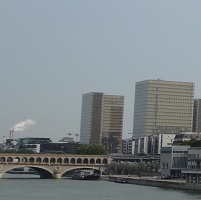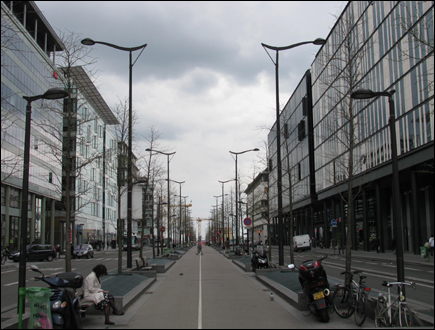
In the 17th century the powers and financiers of Paris began to develop the southeastern zone of the capital by initiating major projects on Ile Saint Louis and in the Marais. Four hundred years later, the focus of development in the capital is once again the southeastern edge, now located a mile further upstream.
North of the Seine in this corner of the city, in the 12th arrondissement, construction in the 1980s was focused on the Bercy and Cour Saint Emilion quarters, with Parc de Bercy at its center. Those quarters are now well established. Far more interesting from an urban planning point of view and thus of particular interest to the exploring Parisphile is the zone south of the Seine, in the 13th arrondissement, a project that goes under the official name “Paris Rive Gauche.”
Paris Rive Gauche? But isn’t that the Saint Germain Quarter and the Luxembourg Garden? Doesn’t Rive Gauche mean famous pastry shops, baby Diors, boutiquey hotels, cute little restaurants, and a café for every mood? Referring to a recent construction zone so far removed from the well-known charms of the 6th arrondissement may indeed sound like sacrilege. This, however, is the Rive Gauche of the 21st century, another Left Bank.

The new Paris Rive Gauche
It may not be quaint or charming or picturesque, it may not have buzz or hype or chic, it may not have stellar chefs and famous chocolatiers, just yet, but ignore the existence of this quarter at the risk of holding an outdated vision of Paris.
Covering a zone previously defined by docks and industry and rail yards, the Paris Rive Gauche project stretches 1.25-mile (2-km) along the Seine from Gare d’Austerliz to the edge of the city and several hundred yards uphill. The project is divided into a half-dozen “quarters” with forgettable names like Austerlitz Sud, Tolbiac Nord, and Masséna-Chevaleret, so for the time being it’s best thought of the National Library or BNF quarter, even though that library is the least appealing part of the area.
Inaugurated in 1996, the François Mitterand National Library (Bibliothèque Nationale de France – François Mitterand) was built as a beacon to the intellectual grandeur of France, but architecturally it comes across as an empty conversation. The library space itself is practical enough, and there’s an attractively foreboding otherworldliness to the inner garden/woods that’s at the heart of the complex, but the vast esplanade within the four corner towers is a sad, windswept zone. And the view of the complex from the river isn’t the least bit inspiring. Perhaps something will be done to make the esplanade more welcoming in the coming years.
What is Paris without its old stones?
In the absence of notable history (architectural, urban, or otherwise), Paris Rive Gauche raises the question as to what Paris is without its old stones.
Paris Rive Gauche might actually be seen as an attempt to create a utopian quarter of Paris, a place where cultural institutions, government, residences (both subsidized and free-market), medical research centers, galleries, shops, café society, universities, fashion and creation centers, sports, cinemas, restaurants, shopping, nightlife, and residents and visitors happily and productively coexist in a zone that simultaneously connects with the historical center, with older neighborhoods nearby, with the close suburbs, and with the river.
That’s a lot to ask of a single development zone—which is precisely why it’s so interesting for the urban travel and the Parisphile to come have a look, even if, as noted above, the zone offers neither charm nor chic.
How to visit the 21st-century Left Bank
If approached as a waterfront area one might begin a visit to Paris Rive Gauche either from the Chevaleret metro station then by walking along the Seine or from across the river at Cour Saint Emilion then by passing through Bercy Park and over the seductive Simone de Beauvoir footbridge to the Left Bank and the National Library. Arriving by bike is another alternative.
But the most startling way to enter into 21st century Left Bank Paris is to enter directly into the heart of the zone by taking the RER C or metro line 14 to the Bibliothèque François Mitterand station and exiting onto Avenue de France.

Avenue de France, the wide, main street behind the library, naturally looks more like new Berlin than it does old Paris. Though it has existed for several years now, the avenue still feels at certain times of day like a street to nowhere or a street to nowhere or main street in an abandoned town. That impression will undoubtedly change though as the surrounding area develops and connects both physically and psychologically with the rest of Paris. There’s a crane in the distance in the photo above.
The riverbank
Already the riverbank attracts a trickle of visitors throughout the year. A steadier stream comes this way from May to September as the riverside has begun to earn its place on the warm-weather map of Paris due to its outdoor lounge-cafés, party boats (e.g.Batofar), the Josephine Baker floating pool (2006), and occasional outdoor summer activities.
Commerce is as yet relatively subdued between the river and avenue de France. Nevertheless there are movie theaters, live theaters, bookshops, bakeries, cafes, and brasseries, galleries and bookshops to remind you that this is indeed Paris. The zone’s busiest store to date—and a major Saturday draw to the area—is Truffaut, the large plant and pet business.
Further developments
Along with the National Library, other institutional projects have begun opening their doors. The Institut Français de la Mode in the old docks by the Austerlitz train station opened in 2009. The Paris-Val-de-Seine School of Architecture and a research center of the Pitié-Salpêtrière university hospital and are now taking shape. A new university campus, Université Paris 7 – Diderot, began welcoming some students in 2005, with the number increasing each year and expected to grow to 30,000 students and staff when the campus is completed in 2012. That same year the tramway ringing the city will be arriving in this sector. As all of the above takes hold and new residential buildings are completed, more restaurants are sure to open.
Though development of the quarter has been steady for 15 years now, fall 2012 appears to be the time that everything will come together, making this zone in full-fledged and effervescent part of the city. New constructions will continue for several years beyond that.
No need to wait though. Twenty-first century Paris Rive Gauche, the other Left Bank, is already on the map.
* * *
For further information about the Paris Rive Gauche project visit the official site.
For return travelers looking for a stroll in one of the lesser-known 19th-century quarters, see this France Revisited photo-report about the Batignolles quarter in the 17th arrondissement.
© 2010, Gary Lee Kraut

